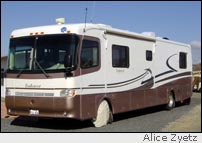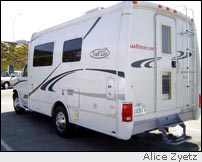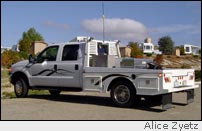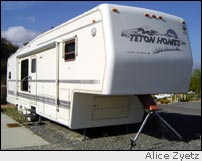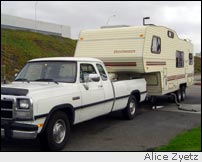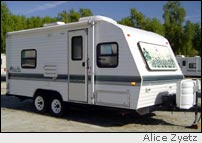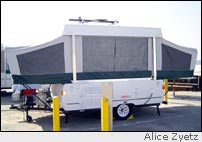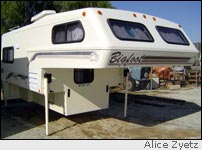| Comparing Types of RVs: Pros and Cons, by Alice Zyetz |
|
The issue of assessing pros and cons is very individual. What is a bonus for one family is a definite liability for another. For example, a small family that wants to travel easily to many destinations for sightseeing will want a small easy-to-handle rig. A family with off-road vehicles that goes to the desert to spend time with other families in one spot to use their sand buggies will want a rig that provides sleeping and eating space but can also haul all their equipment. Or they will want a large trailer with the built-in "garage."
Another concern of course is cost and size. Are you just starting out and unsure of what will work for your family? Are you retired and planning to travel occasionally or will you sell your home and live in the RV full-time? This column will give you some ideas of how to evaluate your options. Before you actually buy, talk to other RVers, rent an RV to get the feel of it, travel with a friend if possible, search out the new RVer Web sites, go to RV shows and dealers (BUT DON'T BUY YET--EVEN IF THEY MAKE YOU AN OFFER YOU THINK YOU CAN'T REFUSE!). When you do buy, I urge you to start with a used vehicle if this is your first. No matter how careful you've been about assessing your needs, there are always nuances you don't realize until you start using your rig. A new rig loses thousands of dollars of value as soon as you drive it off the dealer's lot. A used rig depreciates very slowly.
TYPES OF RIGS
There are two basic types of rigs.
1. Motorized RVs have the driving compartment within
the vehicle. They are constructed on a motor vehicle chassis.
2. Towable RVs rely on a separate vehicle with a driving
compartment.
MOTORIZED RVS
This is the rig most people think of when they hear
the expression "RV." Generally, it's called a motorhome,
ranging in length from under twenty to more than forty feet.
The price can vary from a few thousand dollars for an old
well-worn rig to almost a million for a luxurious, customized
vehicle. Motorhomes are easier to drive and park, plus they
afford greater safety since if there is an emergency or anything
suspicious in the middle of the night, the owner just turns
the key in the ignition and leaves. The trailer owner must
go outside to get into the tow vehicle. Generally solo women
travelers choose motorhomes for these reasons, although one
solo who lives in her fifth wheel trailer (see below for definition)
says that she prefers to stay in RV parks, so she always feels
safe and doesn't worry about leaving in the middle of the
night.
|
CLASS A
The Class A motorhome is often rectangular in appearance.
The driver and passenger seats can swivel around and become
living room furniture when the rig is parked. The amenities
are self-contained bathroom, kitchen, dining area, living
room, and bedroom. Class As handle more like a car (a very
large car for the 30-40 feet rigs) and when you remove
the towed car, they back up like a car so the driver doesn't
have to learn new skills. The larger motorhomes usually tow
a car behind, affectionately referred to as the "toad."
Although the mileage is poor on the motorhome, the toad gets
excellent mileage and is used for local transportation and
sightseeing.( If you will tow a car or dinghy (car trailer)
behind your motorhome, check at www.motorhomemagazine.com
for its Dinghy Towing guide on what cars are towable with
all four wheels on the ground.
Although the motorhome has steps to mount from the outside, once inside there are no further steps, making it easier for a handicapped person to get around. In addition, it is easier for the handicapped person to get in and out of a passenger car than a large truck. Many motorhome owners cite the advantage that the passenger can get up to prepare lunch or go to the bathroom while the vehicle is in motion. In fact, that is a great danger. While tootling down the highway at speeds up to 60 mph, every passenger should be securely seated.
One disadvantage to the larger Class A is having two engines to pay for and maintain. Another concern is that despite the number of stuffed bears they use, people who live in their motorhomes cannot disguise the fact that they have a steering wheel in their living room. For those who are looking for luxurious accommodations on the road, it is generally more expensive to purchase a motorhome and toad than a large fifth wheel and truck.
CLASS B
The Class B is built on a van chassis with a raised
roof. Class Bs are smaller, compact, and very easy to drive.
They contain the same lifestyle amenities, but usually on
a smaller scale. New ones are expensive, particularly compared
to a similar-sized Class C or Class A. The Class Bs have less
sleeping space for a small family than other small rigs or
trailers.
CLASS C
The Class C is a truck chassis with an RV unit built
on it. The sleeping area is over the driver/passenger unit.
Again, the rig contains all the lifestyle amenities but often
on a more limited scale than the Class A. The Class C is often
used to tow a boat or motorcycle, and can tow a car. This
type is the least expensive of the motorhomes.
TOWABLE RVS
The advantage of the towable RV is that when you arrive
at your site, you can unhitch the tow vehicle and use it as
your mode of local transportation.
FIFTH WHEEL
The fifth wheel is a trailer that hitches in the bed
of the truck. Depending on the size and construction of the
rig, it may be too heavy to tow with a big pick-up truck.
Check the weight rating carefully. An overweight vehicle can
cause great problems to the tow vehicle, the trailer, and
ultimately to your personal safety. You might damage the transmission,
axles, tires, and so on. (Check out www.rvsafety.com.)
People who live in a big fifth wheel the majority of the time
often need to purchase a medium duty truck (MDT) to compensate
for the heavy weight of their trailer.
The inside of the rig has all the amenities of the motorhome, including more varied living room layouts. Financially, a luxurious newer fifth wheel and MDT combined is still less expensive than a luxurious motorhome and toad. When it comes time to upgrade, you may only have to replace the fifth wheel or truck, again saving money. The disadvantage is that it usually takes longer to park than the big motorhome. One motorhomer told me that after she parks, she sits down with her glass of wine and waits patiently while her friends in their fifth wheels are still getting it together. Another problem is that it is not as convenient and cost effective to sightsee or do errands in a truck or MDT. In the process of preparing this article, I queried a representative sample of "Boomers" (40- to 50-year-olds who live on the road full-time and belong to the RV club Escapees.com). What I discovered was that the results are evenly matched between owners of large motorhomes and large fifth wheels. The pros and cons seem to balance each other.
For the occasional RVer who would buy a smaller and probably an older fifth wheel, the price and inside space are very appealing IF the family already has a big truck or would use it in their daily work. A larger family would need a truck with an extended cab since it is not safe to have the children inside the trailer as they travel. A motorhome may be more effective.
TRAVEL TRAILER
The travel trailer, more familiar to most people, hitches
to the back of the tow vehicle, which can be a truck, van,
or even a heavy car, depending on the weight and size of the
trailer. The trailer length varies greatly. The longer trailers
tend to sway and don't complete turns as easily as the fifth
wheel. They are also more difficult to back in to a campsite.
Less underneath storage is available than in a fifth wheel.
Full amenities are in the longer trailers. For the family,
there can be more space in the van or heavy car, which makes
pulling a travel trailer a more attractive option than a fifth
wheel. The travel trailer is generally less expensive than
the fifth wheel.
|
POP-UP TRAILER
When closed, a pop-up trailer looks like a box. When opened,
the front and back open and occasionally the sides. The pop-up
trailer is a great starter trailer for a family. Towed easily
by a car or van, it is less expensive than other trailers
and can accommodate a larger family. If you don't already
use a truck, you won't have to go out and buy one. Set-up
and tear-down time is longer and can be frustrating if you
are traveling to a new location each day rather than going
to a single destination and staying there for the whole vacation.
Since the sides are usually canvas, the pop-up can be very
uncomfortable in the rain.
CAMPER
The slide-in camper is a camper shell that can be removed
from the body of a flat bed pickup truck. A "slide-out"
side provides more space, but overall space is limited compared
to most travel and fifth wheel trailers. This is an excellent
rig for one or two people, or it can be used as the tow vehicle
for a travel or pop-up trailer for a larger family.
SLIDE-OUTS: PROS &
CONS
When the newer rig (motorhome or trailer) is parked,
part of the room can "slide out" providing additional
living space, a great advantage to counter the living-in-a-submarine
feeling. The newest models have three and even four slide-outs.
The disadvantages are threefold: 1) This is one more mechanical
part that can be a problem, 2) older campgrounds may not be
able to accommodate the additional space you need, and 3)
you have added more weight to your axles, chassis, and tow
vehicle. You may also give up some basement storage room.
MAKING A CHOICE
Think about your own lifestyle. Are you a weekend traveler?
How many people will be traveling together? What do you plan
to use the rig for? Will you be traveling full-time? Do you
have any physical restrictions that need to be accommodated?
Do you already have a truck? Are you an experienced RVer?
What is your budget range?
Happy trails. It's a great life!
Alice Zyetz
11/6/04

 Alice
Zyetz and Jaimie Hall have
been RVing fulltime with their
husbands for more than ten years
each. Together they have published
two books on the RV Lifestyle:
Alice
Zyetz and Jaimie Hall have
been RVing fulltime with their
husbands for more than ten years
each. Together they have published
two books on the RV Lifestyle:
